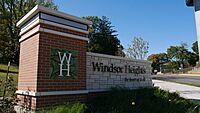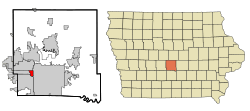Windsor Heights, Iowa facts for kids
Quick facts for kids
Windsor Heights, Iowa
|
|
|---|---|

Windsor Heights Welcome Sign
|
|
| Motto(s):
The heart of it all.
|
|

Location in the State of Iowa
|
|
| Country | |
| State | |
| County | Polk |
| Incorporated | July 19, 1941 |
| Area | |
| • Total | 1.43 sq mi (3.72 km2) |
| • Land | 1.43 sq mi (3.72 km2) |
| • Water | 0.00 sq mi (0.00 km2) |
| Elevation | 876 ft (267 m) |
| Population
(2020)
|
|
| • Total | 5,252 |
| • Density | 3,662.48/sq mi (1,413.61/km2) |
| Time zone | UTC-6 (CST) |
| • Summer (DST) | UTC-5 (CDT) |
| ZIP codes |
50324
|
| Area code(s) | 515 |
| FIPS code | 19-86250 |
| GNIS feature ID | 2397343 |
| Website | http://www.windsorheights.org/ |
Windsor Heights is a city located in Polk County, Iowa, in the United States. In 2020, about 5,252 people lived there. It is part of the larger Des Moines area, which is a big group of cities and towns.
Contents
History of Windsor Heights
Windsor Heights officially became a city on July 19, 1941. It got its name from the nearby Windsor Elementary School in Des Moines. The school was named after Henry Clay Windsor, an early settler whose family gave the land for the school.
In 1958, Windsor Heights grew by adding the community of Crestwood. This added about 1,300 people and set the city's current borders.
On June 26, 2008, the United States Postal Service gave Windsor Heights its own ZIP code, 50324. This started on July 1, 2009. Before this, the city shared ZIP codes with parts of Des Moines and Urbandale.
Geography and Location
According to the United States Census Bureau, Windsor Heights covers about 1.41 square miles (3.7 square kilometers) of land. There is no water area within the city limits.
Windsor Heights is surrounded by other cities:
- Urbandale is to the north.
- Clive is to the west.
- West Des Moines is to the south.
- Des Moines is to the east.
Major roads run through or along the city. Interstate 235 goes through the southern part of the city. U.S. Route 6 (Hickman Road) forms the border with Urbandale. Iowa Highway 28 (63rd Street) forms the border with Des Moines.
Climate in Windsor Heights
| Climate data for Windsor Heights, Iowa | |||||||||||||
|---|---|---|---|---|---|---|---|---|---|---|---|---|---|
| Month | Jan | Feb | Mar | Apr | May | Jun | Jul | Aug | Sep | Oct | Nov | Dec | Year |
| Record high °F (°C) | 67 (19) |
78 (26) |
91 (33) |
93 (34) |
105 (41) |
103 (39) |
110 (43) |
110 (43) |
101 (38) |
95 (35) |
82 (28) |
69 (21) |
110 (43) |
| Mean daily maximum °F (°C) | 31 (−1) |
36 (2) |
49 (9) |
62 (17) |
72 (22) |
82 (28) |
86 (30) |
84 (29) |
76 (24) |
63 (17) |
48 (9) |
34 (1) |
60 (16) |
| Daily mean °F (°C) | 23 (−5) |
28 (−2) |
40 (4) |
52 (11) |
62 (17) |
72 (22) |
77 (25) |
75 (24) |
66 (19) |
53 (12) |
40 (4) |
26 (−3) |
51 (11) |
| Mean daily minimum °F (°C) | 14 (−10) |
19 (−7) |
30 (−1) |
41 (5) |
52 (11) |
62 (17) |
67 (19) |
65 (18) |
55 (13) |
43 (6) |
31 (−1) |
18 (−8) |
41 (5) |
| Record low °F (°C) | −30 (−34) |
−26 (−32) |
−22 (−30) |
9 (−13) |
26 (−3) |
37 (3) |
47 (8) |
40 (4) |
26 (−3) |
7 (−14) |
−10 (−23) |
−22 (−30) |
−30 (−34) |
| Average precipitation inches (mm) | 1.0 (25) |
1.3 (33) |
2.3 (58) |
3.9 (99) |
4.7 (120) |
4.9 (120) |
4.5 (110) |
4.1 (100) |
3.0 (76) |
2.6 (66) |
2.2 (56) |
1.4 (36) |
35.9 (899) |
| Source: weather.com | |||||||||||||
Population and People
| Historical populations | ||
|---|---|---|
| Year | Pop. | ±% |
| 1950 | 1,414 | — |
| 1960 | 4,715 | +233.5% |
| 1970 | 6,303 | +33.7% |
| 1980 | 5,474 | −13.2% |
| 1990 | 5,190 | −5.2% |
| 2000 | 4,805 | −7.4% |
| 2010 | 4,860 | +1.1% |
| 2020 | 5,252 | +8.1% |
| Source: and Iowa Data Center Source: |
||
2020 Census Information
In 2020, the city had 5,252 people living in 2,226 households. The population density was about 3,661 people per square mile.
Most residents (79.6%) were White. Other groups included Black or African American (4.6%), Asian (5.0%), and people from two or more races (8.1%). About 6.7% of the population was Hispanic or Latino.
The average age in Windsor Heights was 39.8 years. About 23.9% of residents were under 20 years old.
Education in Windsor Heights
Students in Windsor Heights attend schools from two different districts. The West Des Moines Community School District (WDMCS) and Des Moines Public Schools (DMPS) both serve the city. 70th Street acts as the dividing line between the two districts.
Both districts have schools within Windsor Heights. Clive Learning Academy serves WDMCS students. Cowles Montessori School serves DMPS students.
Transportation
Public transportation in Windsor Heights is provided by Des Moines Area Regional Transit. Bus routes 3, 74, and 92 connect the city to other areas in the region.
See also
 In Spanish: Windsor Heights (Iowa) para niños
In Spanish: Windsor Heights (Iowa) para niños

